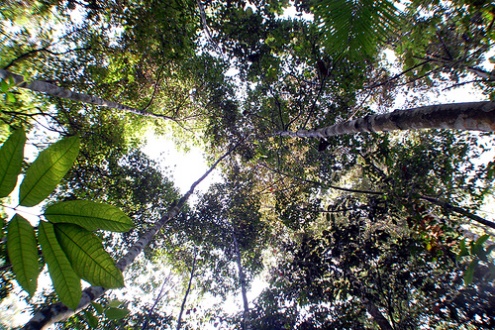Wood exploitation from dipterocarpaceae that economically high, have been decades occurred in Sumatra, Kalimantan and Sulawesi. The Data from the Ministry of Forestry (Kemenhut), for Meranti wood (Shorea spp.) shows, it rises in average production of 14% per year to meet the needs of the market, such as construction and industrial raw materials. These needs are increasingly threatening the amount in nature.
In order to overcome the scarcity of dipterocarpaceae, MOE R&D Center, in cooperation with Komatsu, a Japan company, doing various research and engineering technology to cultivate dipterocarpaceae. “The research has been started since 1993 ago. The technique was developed at first is tissue culture, but it was not feasible with Meranti. After further research, in the fourth year we finally find the vegetative reproduction technology with the tip cuttings,” said Atok Subiakto, sylviculture researcher of MOE Research Center for Conservation and Rehabilitation when contacted by Ekuatorial, Tuesday (2/7).
Atok optimistic with the technology that then named with KOFFCO (Komatsu Forda Fog Cooling System). He said, this technology could solve the problem in the conventional breeding using seeds, which cannot be done due to the irregularity of flowering season and the short seed storage period.
The required time for providing seed is relatively similar to the conventional way. Atok added, results in the field suggests that the growth of Meranti the result of this technology is almost the same with the growth of the natural seedlings. “The average result of tree dimensional growth is 1.6 m2/year, hope we could achieve 2 m2/year, he added.
In response to this, the head of Forestry R&D, San Afri Awang stated that he is proud when visiting the field in Mount Dahu Research Forest, Bogor, West Java, some time ago. “More than 1.6 m2/year for dipterocarpaceae relatively high compared to the developments in the natural forest, and the Public Company Perhutani, which only reached an average of 1 m2/year. That’s what we said stepping technology, he said.
Through various development, this time KOFFCO could also be used for seeds the other high economic wood as Jabon (Anthocephalus macrophyllus), Ramin (Gonystylus bancanus), Nyawai (Ficus variegata), and Rasamala (Altingia excelsa).
Asked about the cost of seedling, Atok explained that KOFFCO cost Rp 2,200 per stem, or higher 700 rupiah compared to regular nursery. Besides in Mount Dahu Research Forest covering 250 acres, this method has been applied in several areas such as Kalimantan Timur, South Kalimantan and Riau. Some companies have already adopted it, such as in the area of operations of PT Sarpatin and PT Sari Bumi Kusuma in Central Kalimantan. Azhari Fauzi.
